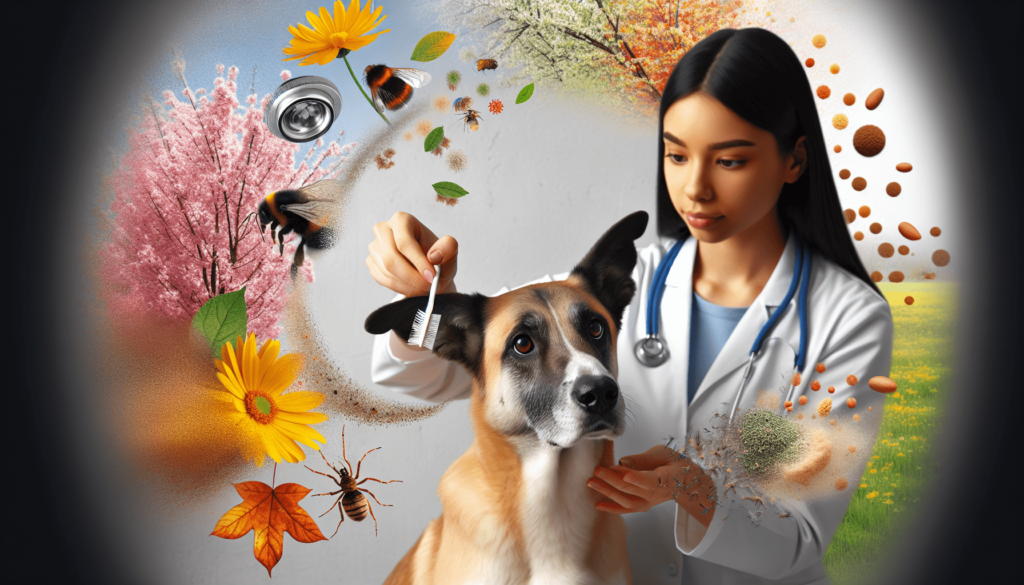You’re not alone in experiencing the joy of springtime. While the blossoming flowers and warmer temperatures bring happiness to many, they also bring a host of seasonal allergies, and not just for humans. Yes, your furry friend can also suffer from seasonal allergies. The constant itching, sneezing, and scratching can be distressing for both you and your dog. But fear not, because in this article, you will discover some simple and effective ways to manage your dog’s seasonal allergies, allowing them to enjoy the wonders of spring without the misery of allergies. So get ready to give your four-legged companion some much-needed relief!

Understanding Seasonal Allergies in Dogs
Seasonal allergies, also known as atopic dermatitis, can be a common issue for dogs. Just like humans, dogs can be allergic to various environmental allergens that are more prevalent during certain times of the year. Some of the most common allergens include pollen from trees, grasses, and weeds, as well as mold spores and dust mites. Understanding these allergens and how they affect your furry friend is the first step in effectively managing their seasonal allergies.
Know the common allergens that trigger seasonal allergies
Knowing the common allergens that trigger seasonal allergies in dogs can help you be proactive in managing their symptoms. Pollen from trees, grasses, and weeds are significant culprits in causing allergic reactions. Dogs can also be sensitive to mold spores, dust mites, and other indoor allergens such as fabrics and certain cleaning products. By identifying these allergens, you can take steps to reduce their exposure and alleviate your dog’s discomfort.
Recognize the symptoms of seasonal allergies in dogs
Identifying the symptoms of seasonal allergies in dogs is crucial in providing them with the necessary care and relief. Some common signs of seasonal allergies include excessive itching and scratching, red and irritated skin, recurrent ear infections, hair loss, sneezing, coughing, and watery eyes. If you notice your dog displaying these symptoms during specific times of the year, it’s likely they are suffering from seasonal allergies. Prompt recognition of these symptoms can help you take appropriate measures to manage their allergies effectively.
Consult a veterinarian to confirm your dog’s seasonal allergies
While observing and recognizing the symptoms can give you a good indication of your dog’s seasonal allergies, it is essential to consult with a veterinarian for a comprehensive diagnosis. A veterinarian can perform allergy testing, such as skin tests or blood tests, to confirm the specific allergens that are triggering your dog’s allergies. This information is valuable in creating an individualized treatment plan for your furry friend, ensuring that they receive the most suitable care for their specific allergies.
Reducing Exposure to Allergens
Limit outdoor activities during peak allergy seasons
During peak allergy seasons, it’s best to limit your dog’s outdoor activities to minimize their exposure to allergens. Pollen levels tend to be highest in the early morning and evening, so try to schedule walks and playtime during other times of the day. Additionally, avoid areas with high concentrations of pollen, such as fields of grass or flowering plants.
Keep windows and doors closed to prevent allergens from entering your home
To create a safe haven for your dog, keep your windows and doors closed during times of peak pollen levels. This will help prevent allergens from entering your home and exacerbating your dog’s seasonal allergies. Instead, rely on air conditioning or fans to keep the indoor environment cool and comfortable.
Regularly clean and vacuum your home to remove allergens
Regular cleaning and vacuuming are essential in minimizing allergens inside your home. Dust mites, pollen, and other irritants can settle on floors, furniture, and other surfaces, making it difficult for your dog to find relief from their allergies. By regularly removing these allergens through cleaning and vacuuming, you can create a cleaner and healthier environment for your furry friend.
Wash your dog’s bedding frequently
Your dog’s bedding can harbor allergens such as pollen and dust mites. To reduce their exposure to these allergens, it’s important to wash their bedding frequently in hot water. This will help eliminate any trapped allergens and provide a clean and comfortable space for your dog to rest.

Maintaining a Healthy Diet
Consider a hypoallergenic dog food
Feeding your dog a hypoallergenic diet can be beneficial in managing their seasonal allergies. Hypoallergenic dog food is specially formulated to minimize the risk of triggering allergic reactions. These diets typically contain novel protein sources, such as duck or venison, and are free from common allergenic ingredients like wheat, dairy, and soy. Consult with your veterinarian to determine the most appropriate hypoallergenic diet for your dog’s specific needs.
Avoid feeding your dog known allergens such as wheat or dairy
Certain ingredients, such as wheat or dairy, can be common allergens for dogs. If your dog is prone to seasonal allergies, it’s best to avoid feeding them these known allergens. Opt for alternative protein and carbohydrate sources that are less likely to trigger allergic reactions in your dog. Your veterinarian can provide guidance on suitable dietary options for your furry friend.
Include omega-3 fatty acids in your dog’s diet to reduce inflammation
Omega-3 fatty acids have anti-inflammatory properties, which can help alleviate the symptoms of seasonal allergies in dogs. They can be found in fish oil supplements or incorporated into your dog’s diet through foods rich in omega-3, such as salmon or flaxseed. Adding omega-3 fatty acids to your dog’s diet can help reduce inflammation and provide relief from itching and irritation caused by allergies.
Supplements and Medications
Consult with a veterinarian about suitable supplements for your dog
There are various supplements available that can support your dog’s immune system and promote overall skin health, which can help manage their seasonal allergies. Supplements such as probiotics, fish oil, and antioxidants can provide additional nutritional support and reduce the severity of your dog’s allergies. However, it’s important to consult with your veterinarian before starting any new supplements to ensure they are safe and suitable for your dog.
Explore options like antihistamines or corticosteroids for symptom relief
In some cases, your veterinarian may recommend medications such as antihistamines or corticosteroids to provide short-term relief from your dog’s allergy symptoms. Antihistamines can help relieve itching and reduce inflammatory responses, while corticosteroids can be more potent in suppressing allergic reactions. However, these medications should be used under the guidance of a veterinarian, as they may have side effects and require specific dosages.
Follow dosage instructions and monitor for any adverse reactions
If your veterinarian prescribes medication for your dog’s seasonal allergies, it’s important to carefully follow the dosage instructions provided. Incorrect use or overdosing can result in adverse effects and may not effectively manage your dog’s allergies. Additionally, closely monitor your dog for any signs of adverse reactions to the medication and communicate with your veterinarian if you have any concerns.
Regular Grooming and Bathing
Brush your dog regularly to remove allergens from their fur
Brushing your dog regularly can help remove allergens from their fur, preventing them from being transferred onto your dog’s skin and causing irritation. Use a grooming brush or comb that is suitable for your dog’s coat type to effectively remove loose hair, dirt, and allergens. Regular grooming not only keeps your dog clean but also helps reduce the severity of their allergy symptoms.
Bathe your dog with a gentle, hypoallergenic shampoo
Bathing your dog with a gentle, hypoallergenic shampoo can help soothe their skin and remove any allergens that may be present on their coat. Choose a shampoo specifically designed for dogs with allergies, as these are formulated to be gentle and free from potential irritants. Avoid using harsh or scented shampoos that may aggravate your dog’s allergies.
Consider using medicated shampoos or wipes recommended by your vet
In some cases, your veterinarian may recommend medicated shampoos or wipes to alleviate your dog’s allergy symptoms. These specialized products often contain ingredients like oatmeal or hydrocortisone, which can help soothe itchy and irritated skin. Always follow your veterinarian’s recommendations regarding the use of medicated shampoos or wipes and discuss any concerns or questions you may have.
Maintaining Clean Ears
Clean your dog’s ears regularly to prevent infections
Regular cleaning of your dog’s ears is essential in preventing ear infections, which can be a common issue for dogs with seasonal allergies. Use a veterinarian-approved ear cleaner and follow proper techniques to gently remove any dirt, wax, or debris from your dog’s ears. Regular ear cleaning helps maintain good ear hygiene and reduces the risk of secondary infections.
Use a vet-approved ear cleaner and follow proper techniques
When cleaning your dog’s ears, it’s important to use a veterinary-approved ear cleaner that is safe and effective. Your veterinarian can recommend a suitable product and provide guidance on the proper technique for cleaning your dog’s ears. Using improper cleaning methods or harsh solutions can potentially cause damage to your dog’s ears, so always consult with your veterinarian for proper instruction.
Monitor for signs of irritation or discharge
After cleaning your dog’s ears, closely monitor for any signs of irritation or discharge. Redness, swelling, an unpleasant odor, or excessive discharge may indicate an underlying ear infection or other issue. If you notice any abnormal symptoms, it’s important to seek veterinary attention promptly to diagnose and treat the problem.
Allergen-free Living Spaces
Create a designated allergen-free zone in your home
To minimize your dog’s exposure to allergens, consider creating an allergen-free zone in your home. This can be a specific area or room where your dog spends most of their time. Remove carpets, rugs, and other fabric materials that can harbor allergens, and ensure proper ventilation in the area. By establishing an allergen-free zone, you provide a clean and comfortable space where your dog can find relief from their allergies.
Consider using air purifiers to reduce allergens in the air
Investing in an air purifier can significantly reduce the number of airborne allergens in your home, benefiting both you and your dog. Air purifiers work by filtering out particles such as pollen, dust mites, and mold spores, improving the overall air quality. Place the air purifier in areas where your dog spends a lot of time, such as the living room or their allergen-free zone, to maximize its effectiveness.
Wash your dog’s paws after outdoor walks to prevent tracking in allergens
After outdoor walks, it’s important to wash your dog’s paws to remove any allergens they may have picked up during their adventures. Use a damp cloth or pet-safe wipes specifically designed for cleaning paws. By removing allergens from their paws, you minimize the chances of them being transferred to your home and reduce the risk of your dog ingesting allergens while grooming themselves.
Managing Outdoor Allergens
Avoid walking your dog during high pollen count periods
During periods of high pollen counts, it’s best to avoid walking your dog outside, especially in areas with high concentrations of allergenic plants. Pollen levels are typically highest in the early morning and evening, so try to schedule walks during other times of the day when pollen counts are lower. This strategy can help minimize your dog’s exposure to allergens and reduce the severity of their allergies.
Wipe down your dog’s coat with a damp cloth after outdoor activities
After your dog has been outside, particularly in areas with high allergenic plants, it’s a good idea to wipe down their coat with a damp cloth. This simple step can help remove any pollen or other allergens that may have clung to their fur. Pay special attention to their paws and face, as these areas are more likely to come into direct contact with allergens.
Rinse your dog’s paws after playing in grass or plants
If your dog enjoys playing in grass or plants, it’s important to rinse their paws after outdoor activities. This helps remove any pollen or other allergens that may have accumulated on their paws. Use lukewarm water and a gentle pet-safe soap to ensure that their paws are thoroughly clean. Drying their paws afterwards is also essential to prevent moisture-related issues, such as fungal infections.
Improve Indoor Air Quality
Regularly change air filters in your home to reduce allergens
Changing air filters regularly is crucial in maintaining good indoor air quality and reducing allergens in the home. Filters can trap pollen, dust, and other allergens, preventing them from circulating in the air. Check the manufacturer’s recommendations for the appropriate frequency of filter changes, and make sure to use high-quality filters that are designed to capture allergens effectively.
Use hypoallergenic cleaning products
When cleaning your home, opt for hypoallergenic cleaning products that are free from harsh chemicals and allergenic ingredients. These products are designed to be gentle and less likely to trigger allergic reactions in your dog. Be cautious of fragrances, as they can also be potential allergens. By using hypoallergenic cleaning products, you can maintain a clean and healthy living environment for both you and your dog.
Keep humidity levels low to prevent mold or dust mites
Maintaining low humidity levels in your home is important in preventing the growth of mold and dust mites, which can be major allergens for dogs. Use a dehumidifier if necessary, especially in areas prone to excess moisture, such as bathrooms or basements. Keeping humidity levels between 30-50% can help minimize the risk of mold and dust mite infestations, promoting a healthier environment for your dog.
Consulting with a Veterinarian
Seek professional advice regarding allergy testing for your dog
If your dog is suffering from severe or persistent seasonal allergies, consulting with a veterinarian about allergy testing is recommended. Allergy testing can identify the specific allergens that are triggering your dog’s symptoms, enabling you to implement targeted management strategies. By understanding the specific allergens affecting your dog, you can make informed decisions about their care and minimize exposure to those allergens.
Discuss potential treatment options and long-term management strategies
When consulting with your veterinarian about your dog’s seasonal allergies, discuss the potential treatment options and long-term management strategies that are available. Depending on the severity of your dog’s allergies, your veterinarian may recommend medications, immunotherapy (allergy shots), or dietary changes. They can provide a personalized treatment plan that addresses your dog’s unique needs, ensuring the best possible quality of life for your furry friend.
Follow your veterinarian’s advice for managing your dog’s allergies
After consulting with your veterinarian and receiving their guidance and recommendations, it’s important to follow their advice for managing your dog’s allergies. This may include implementing lifestyle changes, administering medications or supplements, and attending regular check-ups. By adhering to your veterinarian’s instructions, you can give your dog the best chance for managing their seasonal allergies effectively and improving their overall well-being. Remember, your veterinarian is the best source of advice and support when it comes to your dog’s health and allergies.
In conclusion, understanding, and managing your dog’s seasonal allergies entails various strategies to reduce exposure to allergens, maintain a healthy diet, use suitable supplements or medications, prioritize grooming and cleanliness, create allergen-free living spaces, manage outdoor allergens, improve indoor air quality, and consult with a veterinarian for professional advice. By implementing these comprehensive measures, you can help alleviate your dog’s discomfort and ensure they live a happy and healthy life, free from the burdens of seasonal allergies.

